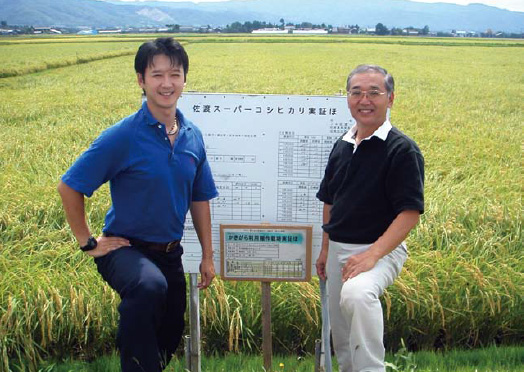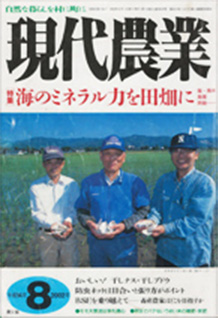ご挨拶
Introductionはじめに
日本海に浮かぶ佐渡島。朱鷺の住む島として知られるその豊かな自然環境。全島にいまも息づく鬼太鼓や能などの伝統芸能。世阿弥や日蓮、佐渡金山にみる歴史文化。そして新鮮な農産物と海産物。そんな佐渡は日本の縮図のようだと言われています。
佐渡のちょうど中央に位置する国仲平野で米づくりを行っているのが株式会社佐渡相田ライスファーミングです。17haの田んぼで3世代、家族7人で営む米農家。佐渡市の旧新穂村、約90世帯ほどの新穂北方という集落にあります。
今回このサイトでは相田家の米づくりの様子とそれを取り巻く様々な人との関係を紹介します。一年を通しての農作業の様子。行政や農協、地元企業やクリエーターとの関係。そして、伝統芸能・鬼太鼓や相田家の様々な出会いまで。
ここに小さくも豊かに暮らしてきた日本の農村にあった原風景を垣間見ていただけたら幸いです。


Introduction
Sado Island, an island floating among the Sea of Japan, referred to as a miniature Japan. Since the island holds rich nature which fosters Toki (Japanese crested ibis) within; practices traditional performing arts such as Ondeko (Demon Drum Dance) and Noh; has histories concerning to Zeami,Nichiren, and Sado mine; and has abundant marine- and agricultural products.
Sado Aida Rice Farming Co. Ltd. grows rice at Kuninaka Plain in the middle of the Sado Island. The plain is located in a small village called Niibokitagata inside Sado city, there only around 90 families reside. The company is very small; run by three generations of a family – (passed down three generations, the current family with~) with only seven members using a patch of land with 17ha.
In this web site, we introduce how we cultivate our rice and how we interact with people around us; for example, a year-round rice cultivation; the relationship with local authorities, Japan Agricultural Cooperatives (JA), local companies, and creators; and the impact of Ondeko.
We would like to introduce to you the peaceful and historical aspects of a Japanese farming village.
米づくりの原点
The starting point of rice cultivation
相田家の米づくりは、代表取締役の相田忠明の父、相田康明からすべてが始まりました。1993 年から本格的に専業農家として米作りをスタート。ブランド米として魚沼産が高い評価を受けている中、佐渡で独自の米作りを模索してきました。そして、佐渡で養殖が盛んな牡蠣の殻に水の浄化殺菌作用や肥料としての効果を見つけ出し、佐渡の牡蠣殻を利用した有機肥料減農薬牡蠣殻稲作農法(以下、カキ殻農法)を作り出しました。
1996年からJA佐渡主催のお米品質コンテストで最優秀賞等を8年連続受賞。2000年には新潟県知事「最優秀賞」と新潟県経済農業協同組合連合会「経済連会長賞」を受賞。2002年には研究・改良を続けてきたカキ殻農法について業界専門誌『現代農業』で特集され表紙を飾りました。
その頃、新潟県が主体となり品質の高い米作りを掲げ「スーパーコシヒカリ」という名称で取り組みが始まりました。我が家のお米も「佐渡スーパーコシヒカリ」として、栽培方法の実証研究が行われました。
これらの取り組みにより、新聞・テレビなどのメディアに取り上げられ、業界団体・行政機関等の視察団が我が家の田んぼに訪れるようになりました。
当時、直接販売はしていませんでしたが(全量をJA佐渡に出荷していました)、伊勢丹新宿本店での新潟米フェア出展をきっかけに交友関係の広い佐渡出身のお客様と出会い、関東を中心に徐々に評判が広がっていきました。これ以降も口コミで、北は北海道、南は沖縄のお客様に広がり「相田家産佐渡スーパーコシヒカリ」のオリジナルブランドとして少しずつ全国的に名前が広がりました。
2010年から相田康明が中心となってきた米づくりに、息子・忠明も加わり、2013年には株式会社佐渡相田ライスファーミングを設立し、代表に相田忠明が就任しました。
私たちは自らを「稲職人」と呼びます。稲を育てるプロフェッショナルとして常に職人魂で米作りと向き合います。稲職人2代で、常に探究心を忘れず、身の丈よりも少し高い場所で勝負し続け、佐渡だからできる米作りを探求しています。
The rice farming of the Aida family was first started by Yasuaki Aida, father of the now CEO Tadaaki Aida. In 1993, he started the business as a full-time rice farmer. Although Uonuma Koshihikari was the most popular rice variey in the region, Yasuaki Aida had searched for his own rice cultivation method. He found out that oyster shells had the effect of water purification, sterization as well as fertilisation, and created an Organic fertilizer reduced agrochemical oyster-shell rice farming method (oyster-shell rice farming method).
Since 1996, the Aidas have continuously received the best prize of Rice Quality Competition hosted by JA Sado. In 2000, the company received Niigata Prefectural Governer’s first prize and Economic Chairman’s prize of Niigata Agricultural Cooperative Associations.
In 2002, we were featured on our oyster shell method in Gendai Nougyou magazine and made the cover of the issue.
In 2003, our rice was named ‘Sado Super Koshihikari’ by relevant administrative units of government and JA Sado, they researched our cultivation method empirically. Subsequently, our rice has been often featured by media such as newspapers and TV programs, and many inspectors from industrial bodies and administrative units of government visited our rice fields.
We do not sell our rice directly to consumers since we entrust the sales to JA Sado, yet at Niigata Rice Fair in Isetan Shinjuku we had a chance to meet customers from Sado. Consumption
of our rice gradually spread in Kanto region. Even after the fair fnished, our reputation spread from Hokkaido, the north-most region all the way down to Okinawa, the south-most by wordof-mouth. Aida’s Sado Super Koshihikari had been gaining its status step by step.
In 2010, Tadaaki, the son of the founder Yasuaki joined in the family business. In 2013, Sado Aida Rice Farming Co. Ltd. was established by Tadaaki as CEO.
We call ourselves ‘Rice Artisan’, since we decided to grow riceprofessionally. Two generations of Rice Artisans have researched and struggled to achieve Sado’s unique rice cultivation.
稲職人に徹する
I devoted to rice craftsman
稲職人、この言葉は10年ほど前、父の名刺を作る際に肩書として私が考えた名称です。職人とは、「熟練した技術を身につけ、手作業で物を作り出すことを職業とする人のこと」と訳されます。本来は、工業的な意味合いで物を作る人を指すことが多いですが、私はこの〈稲職人〉という言葉が気に入っています。
日本人にとってお米は世界中のどの国よりも大切な宝物だと思います。これほどお米を愛し、その全ての工程にこだわる国はないと思います。島国だからこそ、小さな土地を有効に使う知恵を育んできました。また四季の恵みをもたらす自然への感謝と慎み深さを持ってお米を作り続けています。
私は、日本人として、佐渡人として、生まれ育った故郷で「お米作りができる幸せ」を身体全体で感じています。本格的に米作りを始め5年目ですが、一年ずつ確実にその幸せを感じています。収穫の秋を迎え、豊作の年もあれば汗水たらして頑張ったことが報われない年もあります。そして、すぐ次の一年に向けて米作りが始まります。兼業農家の頃から50年近く米作りをしている父や、70年以上の隣のじーちゃんも、毎年悩みながら米作りをしています。自分の育てた稲が納得したお米を実らせてくれるのか…、それだけを目標に日々田んぼに向かいます。
食の多様化によりご飯を食べる日本人が少なくなったと言います。私もパンもパスタもラーメンも大好きです。時代の流れで仕方ないことだと私は思います。しかし、「美味しいごはん」は、いつの時代も日本人にとって大切な宝物。それだけは日本人の心に生き続けます。そして、その宝物は海を越え大陸を越え世界中の人から愛される「日本のごはん」として必要とされています。
私の周りにいる多くの〈稲職人〉から、もっと多くのことを学ばなければいけません。父の背中を追いかけ、理想とすべき〈稲職人〉になる為に、また始まる来年の米作りに向かって、前に進みます。
Rice Artisan - I came up with this title when I was making my father’s business card. The definition of artisan is an occupational craftperson with experience and skills. The word artisan usually refers to those who in manufacturing industry, however, I like to be called Rice Artisan.
I believe Japanese people love rice more than anyone else in any other countries. Not only that, we also care the process of ricecultivationvery much. Japan as a small island country has always tried to make the best use of the limeted land area without forgetting gratitude and modesty to the nature where blessed by four seasons.
I am very happy from the bottom of my heart that I can contribute to rice cultivation industry in a place where I was born and grew up. It’s only five years since I have started working as a rice artisan, still I feel so happy to see rice plants to grow each year. There were some years all our effort turned out to be wasted in harvestingseason, and yet we had to start preparing for the coming year soon afterwords. Everyone in this indutry struggle to produce their ideal rice every year. Even my father who has almost forty years
experience, as well as an old man next door who has more than sixty years experience do so. All of us work in the rice field only to grow one’s ideal rice.
Nowadays it is said Japanese people consume less rice as our diet diversifies. I am no exception; I like breads, pastas, and ramens. Dietary practices are changed with time, and it is inevitable. However, rice has always remained the most important item on our dining tables, and it will be in the future as well. And Japanese rice, our treasure, will be delivered to overseas and be loved by people from all over the world.
I still need to learn more about rice cultivation from surrounding rice artisans. To become my ideal rice artisan, I will follow my father and do my best for the coming year’s rice cultivation.
世界農業遺産の島「佐渡ヶ島」で
稲職人「相田家」が妥協なしに育てたお米、是非ご賞味ください!